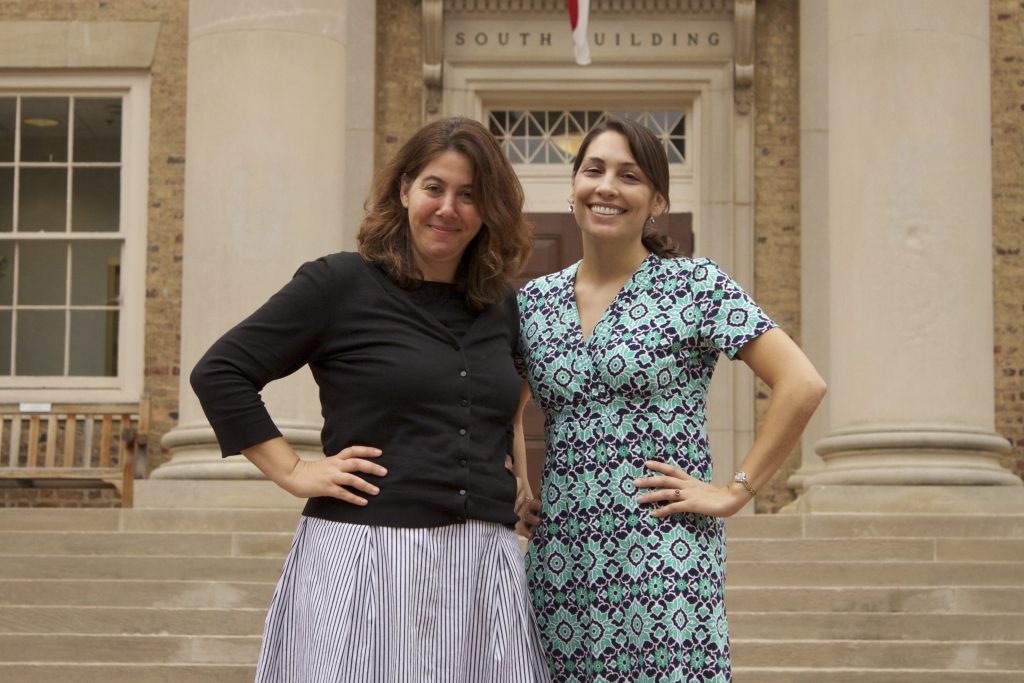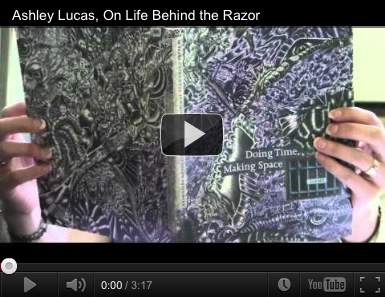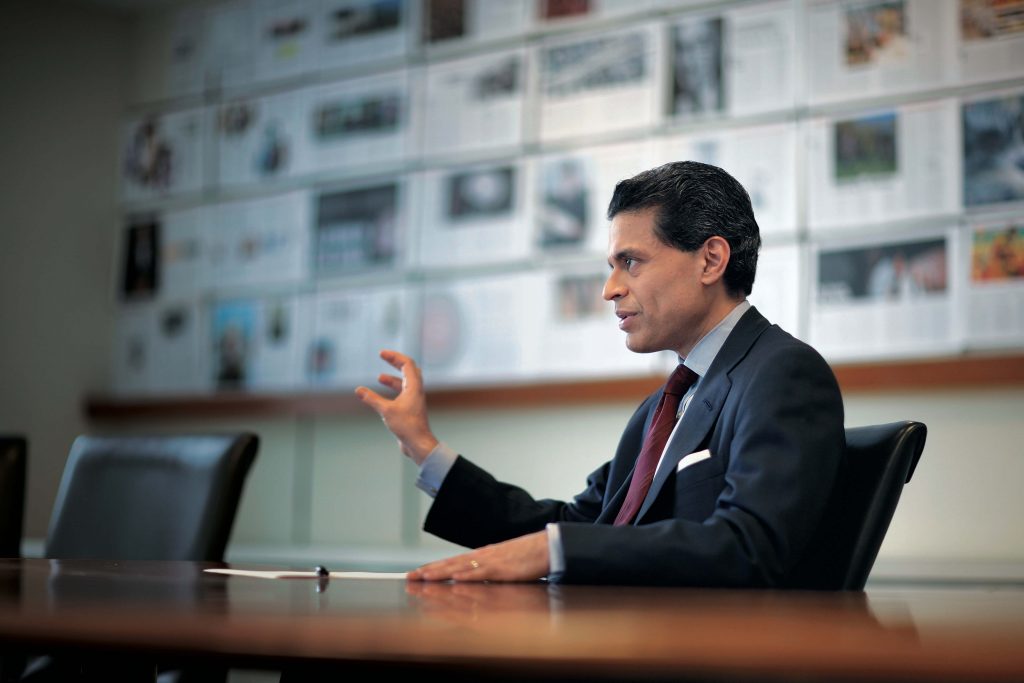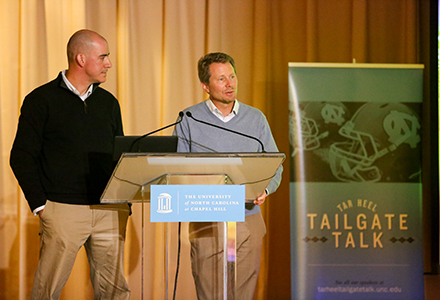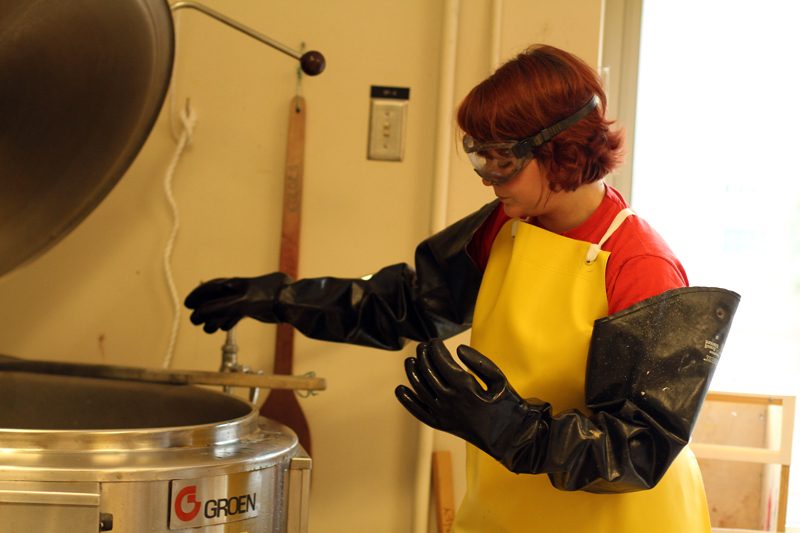
When second-year graduate student Adrienne Corral (watch photo slideshow) dons her neoprene yellow apron, goggles and shoulder-length black gloves, she looks a bit like a scientist in a lab. Steam is rising from a 60-gallon vat of boiling water, which she has turned kelly green for the occasion.
Corral is pursuing an MFA degree in costume production, and on this day, she’s dyeing 16 prison-issue undergarments from brown to military green for the world premiere of PlayMakers Repertory Company’s “The Parchman Hour: Songs and Stories of the ’61 Freedom Riders” (Oct. 26-Nov. 13). “The Parchman Hour” is written and directed by UNC graduate Mike Wiley.
The play chronicles the story of the college-age students who challenged segregation by riding buses into the Deep South in the summer of 1961. Many were incarcerated in Mississippi’s notorious Parchman Farm Penitiary, where they kept their spirits up with a nightly “variety” show.
Corral explains what it takes to get just the right amount of color for these period costumes, balancing the need for both authenticity and practicality.
“I’ll stir it pretty continuously for about 15 minutes, then we take the shorts out and run it through a washing machine with a special soap called synthrapol that takes out excess dye so the garments can be washed with other things,” Corral said, as she stirs the bubbling brew with a large wooden paddle.
Dyeing fabric is just one of the many things that goes on behind the scenes in costuming a show. The department of dramatic art in UNC’s College of Arts and Sciences offers a three-year master’s degree in costume production. Judy Adamson (see related story), costume director for PlayMakers and head of the costume production program,will be recognized in March 2012 with the Distinguished Achievement in Education Award from the United States Institute for Theatre Technology (USITT).
Rachel E. Pollock is serving as costume designer for “The Parchman Hour.” She began the process of researching ideas in April, meeting with director Wiley, and searching through fashion catalogues, music magazines and other periodicals from the time period, as well as books and films on the Freedom Riders. Eric Etheridge’s book, Breach of Peace: Portraits of the 1961 Mississippi Freedom Riders, was a particularly valuable resource.
The military green undergarments will be worn on the set by the imprisoned Freedom Riders. But creating striped prison uniforms for the long-term Parchman inmates presented both a challenge and an opportunity. Most of the existing costumes Pollock could find were too flimsy and cartoonish or too modern-day to fit the time period. Pollock had experimented with digitally produced fabric before and had taken a textiles class in digital printing at N.C. State.
She first created a file in Adobe Photoshop of a 2-inch faded fabric stripe, then uploaded that to the Web site of custom-printed fabric company, Spoonflower, based in Durham. She ordered “fat quarters,” large cotton twill swatches of the material so Corral, who is serving as crafts artisan for the show, could experiment with aging the material to look sun-touched and well-worn. Pollock wrote about the experience on PlayMakers’ blog. She also presented a poster on the art of digital printing for “Parchman Hour” at a recent USITT Southeast design expo, and won the Stell Award for faculty entries.
“Another challenge with ‘Parchman Hour’ is that a lot of the Freedom Riders are still alive, so you want to make sure you are presenting the characters in as true and respectful a fashion as you can,” said Pollock. “It’s always a challenge to do a world premiere because from a dramaturgical perspective there’s no body of information that exists about costumes from previous productions.”
The color palette for the show was in part inspired by the work of Charlotta Janssen, a Brooklyn, N.Y.-based artist discovered by scenic designer McKay Coble and video designer Roz Fulton when they were researching the world of the play. Janssen painted portraits and collages of the Freedom Riders based on their mug-shot images, using black, white, teal and iron oxide (rust). An exhibition of her paintings will be on display in the lobby of the Paul Green Theatre during the run of the show.
First-year graduate student Kelly Renko is serving as assistant to the designer for “Parchman Hour.” She was in charge of pulling costumes from the time period from PlayMakers’ existing stock to create a “boutique” of garments for the designer and director to review. Renko, assisted by undergraduate students, had to pull garments according to a very specific color palette and by sizes of the actors. The costume team also borrowed some clothes from Triad Stage and N.C. State and purchased some from dealers like http//:www.ballyhoovintage.com.
“We have a vast amount of jackets and suits from the time period,” said Renko, who gestures to a rack of costumes and shelves of shoes in one of the fitting rooms. “The Freedom Riders were told to dress as if they were going to a church or job interview.”
Costume director Adamson said it’s the production staff’s job to fulfill the designer’s vision.
“When that works, it’s really exceptional,” she said, of seeing the final costumes on stage.
[Story by Kim Weaver Spurr ’88, photo slideshow by Mary Lide Parker ‘10]

